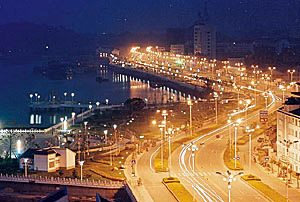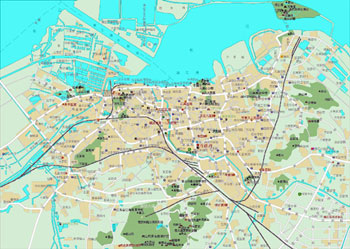China Zhenjiang City:
Zhenjiang

Resident People:2.65 million (urban population: 580,000 million)
General Information:Zhenjiang is an ancient city, founded under the Eastern Zhou Dynasty in 545 BC. Al-though there has been a considerable amount of new construction in recent years, most of the buildings are two- and three? storey structures pre?dating World War II. The streets are lined with hundreds of shade -giving sycamore trees, planted since 1949 to absorb the summer heat.
Geography:Zhenjiang is located on the south bank of the Yangzi River (Chang Jiang), 200 km (120 miles) northwest of Shanghai and 60 km (40 miles) east of Nanjing.
Zhenjiang Map


Climate:Situated in the north part of subtropical zone with the monsoon climate; frost-free of 23.7 days, average sunlight of 2057.2 hours, frog period of 20 days.

Zhenjiang Economy:Today, Zhenjiang is a medium?sized industrial city. Due to the convenience of both its land and water transportation, Zhenjiang's industrial production has developed rapidly. Industries here include metallurgy, machine building, automobile and ship construction, electronics, textiles, plastics, pharmaceuticals, and food processing. The city is situated in a major rice and cotton growing area.
History:Zhenjiang was the seat of feudal domains from the 8th century BC onwards. After it was captured by Qin, the first Chinese emperor, in 221 BC, it became a county town. After being conquered by the Sui in 581 AD, it was made a garrison to guard the entrance to the Yangzi River. Its importance grew with the building of a precursor to the Grand Canal, when it became the chief collection and forwarding center for tax grain paid by the Yangzi delta region.
The city reached its zenith under the Song dynasty (960-1279), when it produced fine silks, satins, and silverware for the emperors. In about 1300, a census reported that some Nestorian Christians were living in Zhenjiang.
Zhenjiang suffered from strife during the Opium War (1839-42) when it was bombarded by British warships, and again during the Taiping Rebellion (1850-1864). Zhenjiang declined economically with the closure of the northern portion of the Grand Canal in the 1850s, and the obstruction of the entrance to the southern canal in the 20th century.
From 1928 to 1949, during the Nationalist (Guomindang) regime of Chiang Kaishek, Zhenjiang was made the capital of Jiangsu Province, while Nanjing (the present-day capital of Jiangsu) served as the capital of China.
Zhenjiang is still one of China's busiest ports for domestic commerce, serving as a hub for trade between northern Jiangsu and Anhui provinces, and Shanghai. The trade mostly consists of grain, cotton, oils, and lumber. The other main industries are mostly in the field of food processing and paper pulp manufacturing. It is famous among Chinese for its heroic resistance against the British (in 1842 and 1949) and the Japanese (in the Second World War).
Arrive:It is located on the Shanghai?Nanjing railroad and the Beijing, Hangzhou Grand Canal. It serves as a busy harbor on the Yangtse transportation route.
Zhenjiang Tourism:Zhenjiang is surrounded on three sides by hills and mountains. In the southern suburbs, these vertical peaks are planted with countless old trees and bamboo groves. The natural beauty and peacefulness of this area have camed Zhenjiang the nickname of "City Forest Hill".
Cuisine:A local specialty is a steamed meat pastry called Crab Cream Bun. Other famous special products include fragrant vinegar, pork, and pickles
Zhenjiang Attractive points:Jiao Hill
Jiao Hill is situated in the middle of the Yangtze River, 4.5 kilometers northeast of Zhenjiang City. Seventy-one meters above the sea level, the hill covers an area of thirty-eight hectares. It was originally named "Qiao Hill". Legend goes that in order to memory the hermit of the Eastern Han Dynasty Jiao Guang who once lived here, Emperor Zhenzong of the Song renamed the hill as Jiao Hill. The hill was covered with greenery which make it look like a piece of floating jade on the river, hence its another name "Fuyu Hill" (Floating Jade Hill).
Dinghui Temple, first built in the Eastern Han Dynasty (25 - 220), is the largest of all the temples on Jiaoshan Hill. It was originally named Puji Temple and was renamed as Puji Buddhist Temple in the Song Dynasty and Jiaoshan Temple in the Yuan Dynasty. During the Qing Dynasty (1644 - 1911), when Emperor Kangxi made a tour of this mountain, its named was changed to Dinghui Temple, the one we used today.
The temple lies on the hill and is magnificent in scale. During the Ming Dynasty (1368 - 1644) when it reached its golden ages, it has 98 halls, 3000 monks and 18 additional temples beside it. The mountain gate of Dinghui Temple, simple and elegant, was open to the south. A pair of stone lion dated from the Ming Dynasty guards the gate and a tablet written with "Dinghui Temple in Jiaoshan" was hung above the gate.
Daxiongbaodian Hall is the main building in this temple. It keeps the style of the Ming and is magnificent and grand with an ornately painted and carved ceiling, red pillars, and cool stone floors. Statues of Sakyamuni, Akshobhya and Amitabha are enshrined inside, with eighteen arhats line up on both sides. All these figures are various and vivid in expressions and gestures. In front of the hall are two 500-year-old ginkgo trees. Having experienced rains and winds for thousands of years, they are still exuberant and verdant.
To the southwest of Dinghui Temple is Huayan Pavilion, which is 2 stories high. On its eastern, southern and western sides, one can enjoy the scenery of the Yangtze River. It is also one of the three well-known places in Zhenjiang for admiring the full moon.
Jiao Hill is also known as a "Hill of Calligraphy". It contains a famous Forest of Tablets which include over 400 stone tablets inscribed in the handwriting of some of the best known calligraphers in China dating from the 7th century to the present. The most famous tablet is "Praising the Crane" which has been regarded as the masterpiece of huge characters.
A trip to the mountain is well worth the effort not only because of the pleasure one can derive from a few minutes exercise in unspoiled nature, but also because of the terrific view from the top of the mountain.
Jinshan Hill Park
Jinshan Hill, with an altitude of 43.7 meters, is situated in the northwest of Zhenjiang City, 3 kilometers from the city center. It was originally an islet situated in the middle of the river. Later, because of the constant deposits of mud and sand, it has been connected to the land.
Jinshan Hill is noted for its enchanting sceneries. The temple on the hill is said to be built in the Eastern Jin Dynasty. As the temple is built along the hill with one layer over another, there is a common saying that "the temple covers the hill". In the mythical tale of "Legend of the White Snake", the story of the white snake Bai Suzhen inundated Jinshan Hill was happened there.
In this tale, Fa Hai, a monk of Jinshan Temple, demolished the marriage between white snake and her husband. Failed in asking the monk for her husband, the white snake, making use of her theurgy, inundated the temple. Today, two caves separately named Fahai Cave and White Snake Cave existed relate this story to people.The Buddhist pagoda at the top of the hill was built in the Qing Dynasty and of the brick and wood structure in imitation of the style of the Song Dynasty. It has seven stories. Zhongleng Spring which is to the west of Jinshan Hill is also called "No.1 Spring under Heaven".








